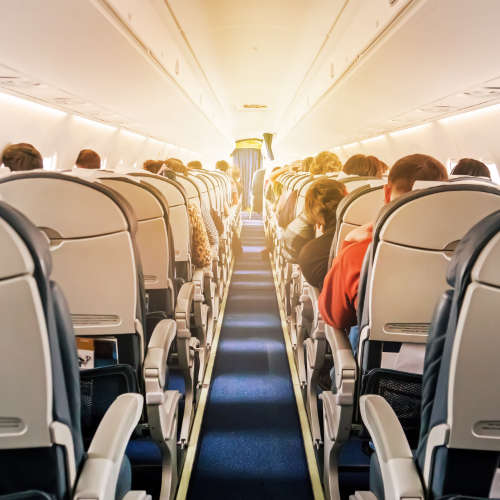AIR TRAVEL & HOLIDAYS
Traveling by air is one of the most carbon emission intensive activities we can do. Every hour of air travel for a typical large commercial plane requires over 2,500 liters of jet fuel. Over the past five years there has been an increase in emissions through air travel by 32% worldwide. Lowering carbon emissions globally in the flight sector would be achievable if individuals and businesses just considered their need for travel a little more.
Read More
Offset Your Flight With Carbon Credits.
It’s an uphill battle to convince people not to explore the world and travel by plane. You have limited holidays and you want to see all the amazing places around the world. The realistic way to reduce the impacts of travel and all of life’s impacts is to offset the carbon emissions with carbon credits. It’s not a perfect solution but you are mitigating the greenhouse gases generated from your activities and helping to develop sustainable energy infrastructure around the world.
You can also consider the following lifestyle changes to lower individual and businesses carbon footprint.
1. Less Frequent Air Trips
If at all possible, air travel should be avoided to achieve the lowest amount of emissions released per year. However, air travel cannot be avoided. From visiting distant family, holidays and business trips, there will be occasions when air travel is necessary.
From a business perspective, business meetings and trips can be replaced in a lot of instances with video conferencing platforms. The change and adoption to video meetings has been accelerated by Covid and is a great way to keep in touch with relatives as well as host meetings. Additionally, they save time and money.
2. Re-Consider Holidays
Holidays and time away from work with friends and family are essential for leading a healthy life. Taking holidays has been shown to boost work productivity and overall happiness. However, when most plan holidays they tend to strive for long distance trips that require air travel. Consider longer stays at the destination to get the most value from the air travel component.
To avoid excess emissions, get creative and find new places to explore within a reasonable driving distance. Staycations allow one to discover hidden gems where one lives that would normally be missed if traveling a far distance away. Many would be surprised with how many beautiful, interesting, and worthwhile places to visit can be found without traveling by plane.
3. Longer Stays
Whether traveling by air or another mode of transportation, the longer you are able to remain in a location, the better. Avoid multiple short stay trips, as they expend greater levels of emissions. Longer trips also allow more time to enjoy the location and excursions.
4. Fly Economy Class
Choosing economy class to travel is the best option. Similar to carpooling, flying economy class is more environmentally efficient. The carbon emissions are shared amongst more passengers. Flying on private airplanes, first class or business class is unfortunately just not efficient.
Read Less




Air Travel and Holidays




Traveling by air is one of the most carbon emission intensive activities we can do. Every hour of air travel for a typical large commercial plane requires over 2,500 liters of jet fuel. Over the past five years there has been an increase in emissions through air travel by 32% worldwide. Lowering carbon emissions globally in the flight sector would be achievable if individuals and businesses just considered their need for travel a little more.
Read More
Offset Your Flight With Carbon Credits.
It’s an uphill battle to convince people not to explore the world and travel by plane. You have limited holidays and you want to see all the amazing places around the world. The realistic way to reduce the impacts of travel and all of life’s impacts is to offset the carbon emissions with carbon credits. It’s not a perfect solution but you are mitigating the greenhouse gases generated from your activities and helping to develop sustainable energy infrastructure around the world.
You can also consider the following lifestyle changes to lower individual and businesses carbon footprint.
1. Less Frequent Air Trips
If at all possible, air travel should be avoided to achieve the lowest amount of emissions released per year. However, air travel cannot be avoided. From visiting distant family, holidays and business trips, there will be occasions when air travel is necessary.
From a business perspective, business meetings and trips can be replaced in a lot of instances with video conferencing platforms. The change and adoption to video meetings has been accelerated by Covid and is a great way to keep in touch with relatives as well as host meetings. Additionally, they save time and money.
2. Re-Consider Holidays
Holidays and time away from work with friends and family are essential for leading a healthy life. Taking holidays has been shown to boost work productivity and overall happiness. However, when most plan holidays they tend to strive for long distance trips that require air travel. Consider longer stays at the destination to get the most value from the air travel component.
To avoid excess emissions, get creative and find new places to explore within a reasonable driving distance. Staycations allow one to discover hidden gems where one lives that would normally be missed if traveling a far distance away. Many would be surprised with how many beautiful, interesting, and worthwhile places to visit can be found without traveling by plane.
3. Longer Stays
Whether traveling by air or another mode of transportation, the longer you are able to remain in a location, the better. Avoid multiple short stay trips, as they expend greater levels of emissions. Longer trips also allow more time to enjoy the location and excursions.
4. Fly Economy Class
Choosing economy class to travel is the best option. Similar to carpooling, flying economy class is more environmentally efficient. The carbon emissions are shared amongst more passengers. Flying on private airplanes, first class or business class is unfortunately just not efficient.
Read Less
Air Travel and Holidays
Traveling by air is one of the most carbon emission intensive activities we can do. Every hour of air travel for a typical large commercial plane requires over 2,500 liters of jet fuel. Over the past five years there has been an increase in emissions through air travel by 32% worldwide. Lowering carbon emissions globally in the flight sector would be achievable if individuals and businesses just considered their need for travel a little more.
Offset Your Flight With Carbon Credits.
It’s an uphill battle to convince people not to explore the world and travel by plane. You have limited holidays and you want to see all the amazing places around the world. The realistic way to reduce the impacts of travel and all of life’s impacts is to offset the carbon emissions with carbon credits. It’s not a perfect solution but you are mitigating the greenhouse gases generated from your activities and helping to develop sustainable energy infrastructure around the world.
You can also consider the following lifestyle changes to lower individual and businesses carbon footprint.
Read More
1. Less Frequent Air Trips
If at all possible, air travel should be avoided to achieve the lowest amount of emissions released per year. However, air travel cannot be avoided. From visiting distant family, holidays and business trips, there will be occasions when air travel is necessary.
From a business perspective, business meetings and trips can be replaced in a lot of instances with video conferencing platforms. The change and adoption to video meetings has been accelerated by Covid and is a great way to keep in touch with relatives as well as host meetings. Additionally, they save time and money.
2. Re-Consider Holidays
Holidays and time away from work with friends and family are essential for leading a healthy life. Taking holidays has been shown to boost work productivity and overall happiness. However, when most plan holidays they tend to strive for long distance trips that require air travel. Consider longer stays at the destination to get the most value from the air travel component.
To avoid excess emissions, get creative and find new places to explore within a reasonable driving distance. Staycations allow one to discover hidden gems where one lives that would normally be missed if traveling a far distance away. Many would be surprised with how many beautiful, interesting, and worthwhile places to visit can be found without traveling by plane.
3. Longer Stays
Whether traveling by air or another mode of transportation, the longer you are able to remain in a location, the better. Avoid multiple short stay trips, as they expend greater levels of emissions. Longer trips also allow more time to enjoy the location and excursions.
4. Fly Economy Class
Choosing economy class to travel is the best option. Similar to carpooling, flying economy class is more environmentally efficient. The carbon emissions are shared amongst more passengers. Flying on private airplanes, first class or business class is unfortunately just not efficient.
Read Less





Carbon Offset Advisory acknowledges the traditional owners and custodians of country throughout Australia and acknowledges their continuing connection to land, water and community.
We pay our respects to the people, the cultures and the elders past, present and emerging.

